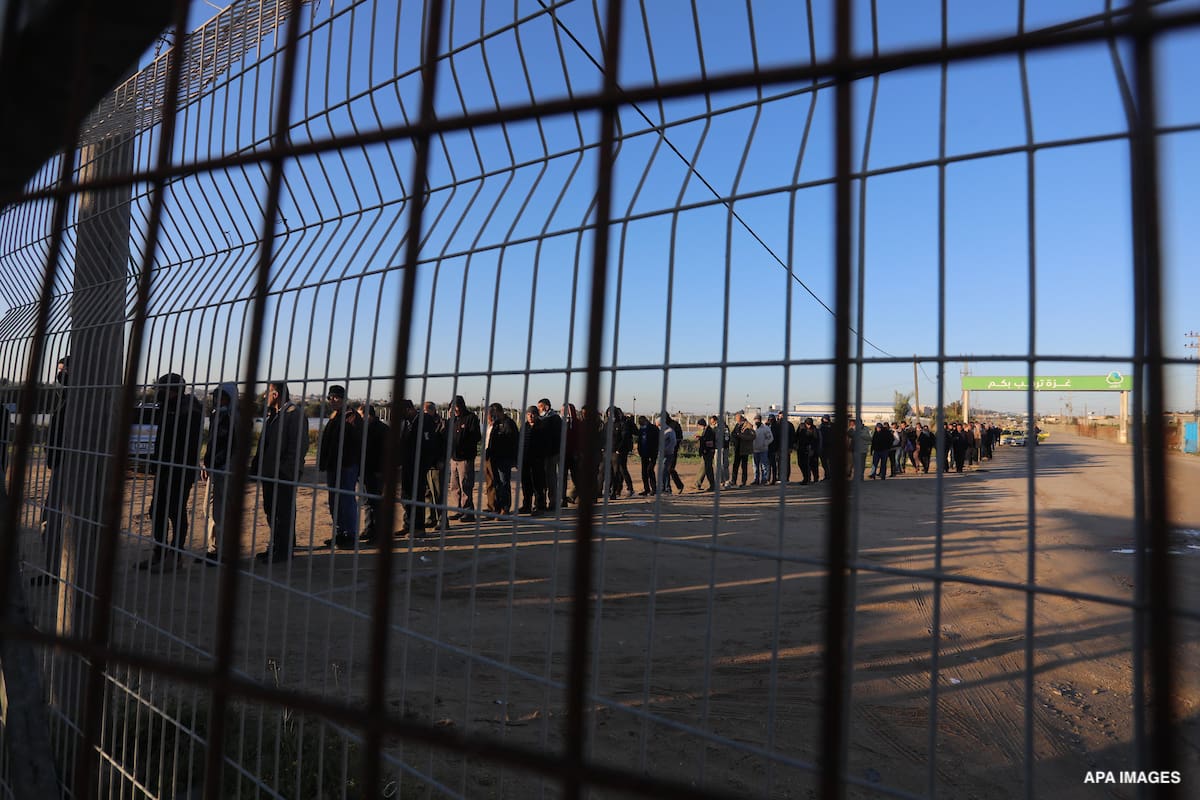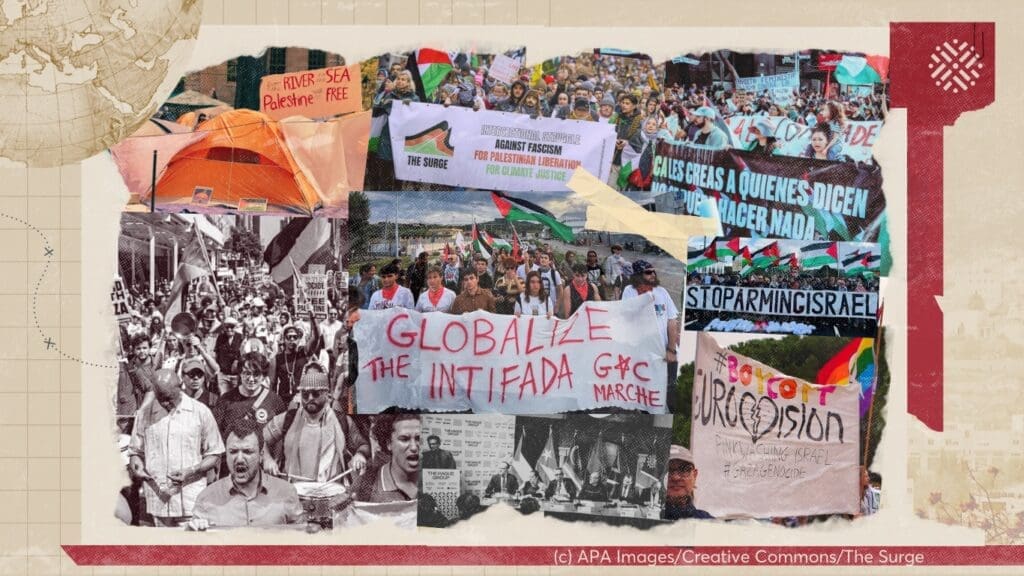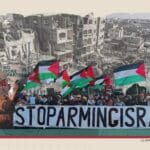
Introduction
Since the start of the genocide in Gaza, Palestinian laborers working in the Israeli market have become a top target for Israel’s Civil and Economic Affairs Cabinet and the Knesset’s Foreign Affairs and Defense Committee. Among a series of decisions taken by the Israeli government following October 7, 2023, was the cancellation of work permits for more than 140,000 Palestinian workers from the West Bank and Gaza. Additionally, thousands of these workers were illegally detained and transferred to detention centers. At the same time, the Israeli government began formal discussions with various Asian governments to recruit thousands of foreign workers to replace the Palestinian labor force.1
This policy brief situates the Israeli government’s current actions against Palestinian workers within the broader historical context of the Zionist settler-colonial project’s relationship with Palestinian labor. It reveals a recurring pattern in which Israel summons, exploits, expels, or replaces the Palestinian workforce based on its needs. This calculated approach, as the brief argues, is designed to systematically dismantle Palestinian political, economic, and social structures, ultimately advancing the goal of Palestinian erasure.
Israel’s Historical Approach to Palestinian Labor
Early Zionist Exclusion
From the outset of the settler-colonial project in Palestine, Palestinian workers were a significant concern for Zionist leaders. While the struggle for the land has always been at the heart of Zionist efforts, the colonial regime intrinsically linked labor to its logic of dispossession. Indeed, controlling Palestinian labor meant that Zionists held sway over Palestinian livelihood, sustainability, and presence on the land.
Labor Zionism was the dominant ideology in the early years of the Zionist project. Its proponents advocated for the exclusion of Palestinian workers to create the Jewish workforce necessary for establishing a Jewish state. Seeking to bridge the gap between international socialism and Jewish nationalism, Labor Zionists used slogans such as “Conquest of Labor” and “Hebrew Labor,” which called on European Jews to build an exclusively Jewish economy.
Palestinian workers found themselves to be, by design, a low-wage reserve labor force for the very regime that had ethnically cleansed their historic homeland Share on X
This ethos culminated in the establishment of Israel’s national trade union federation, the Histadrut, in 1920. From its first conference in Haifa, the union’s founders—including David Ben-Gurion, Israel’s first prime minister—made no secret of their intent to exclude Palestinian workers in the name of building an exclusively Jewish society in Palestine and prioritizing national interests over profit.
As Jewish migration to Palestine increased in the 1930s and 1940s, however, the expanding settler economy necessitated the recruitment of a larger workforce. Consequently, Jewish settlers began hiring Palestinian workers at higher rates, drawing Palestinians away from local indigenous industries. This period saw Zionist attempts to exclude and re-incorporate Palestinian workers on demand, seize Palestinian lands, and consequently displace Palestinian farmers, forcing them to search for labor opportunities elsewhere. The inevitable outcome of this practice was the shrinkage of the Palestinian agricultural and industrial sectors in the lead-up to total upheaval in the 1948 Nakba.
From the Nakba to Oslo
Zionist militias expelled over 700,000 Palestinians during the Nakba. While the Israeli regime granted citizenship to the roughly 150,000 Palestinians who remained within its borders, it stripped them of their land and subjected them to a series of discriminatory laws that sought to entrench their political and economic subjugation.
By the mid-1960s, Palestinians in the 1948 territories made up a significant part of Israel’s labor force. No longer considered a demographic threat, they primarily worked in the agriculture, construction, and manufacturing sectors in lower-wage roles. This employment approach served Israel’s policy of containment, utilizing Palestinian labor for production needs while ensuring their continued systemic impoverishment.
Following the 1967 war, Israel extended work permits to Palestinians from the West Bank and Gaza. Similar to its logic toward Palestinian citizens of Israel, the Israeli regime aimed to use these permits as a means to thwart mounting popular resistance. This strategy further increased Palestinian dependency on the Israeli economy while Israeli settlers continued to seize Palestinian land and natural resources.
Thus, this post-Nakba period marked a departure from the early Zionist policy of exclusion. Instead, a system of controlled inclusion in the Israeli labor market presented the colonial state with an opportunity to subjugate and manage Palestinians while undermining local Palestinian economic sectors and the possibility of self-sustainability. Palestinian workers found themselves to be, by design, a low-wage reserve labor force for the very regime that had ethnically cleansed their historic homeland. This colonial labor policy continued until the First Intifada when Israel imposed severe restrictions on the indigenous population and began replacing Palestinian workers with immigrants from the former Soviet Union.
Oslo and the Second Intifada
In the wake of the First Intifada, the Oslo Accords ushered in a promise of statehood for Palestinians in the West Bank and Gaza. The agreement, however, did not stop Israel’s dispossessive labor policies that have continued to undermine the ability of the Palestinian people to become economically independent. Indeed, by maintaining de facto control over the Palestinian economy and resources, the Israeli regime was able to continue its subjugation of the Palestinian workforce. By 1999, nearly 23% of the total Palestinian workforce from the West Bank and Gaza worked in the Israeli economy. This rate dropped to less than 10% by 2005, however, after the Israeli state implemented a series of collective punishment measures against the indigenous population during the Second Intifada.
The Israeli regime's approach to Palestinian labor rests on a primary goal: to make everyday life so unbearable that Palestinians are forced to leave their homeland Share on X
After the Second Intifada, Israel intensified its bantustanization of the West Bank, annexing more land, establishing more checkpoints, and building the apartheid wall. This strategy aimed to diminish Palestinian presence and dismantle their ability to remain on their land, but it was also part of an effort to undermine Palestinians’ ability to engage in agriculture, industry, and trade. These measures created a significant structural gap between the costs of production in the Palestinian and Israeli economies, favoring the latter and gradually dismantling many Palestinian productive and agricultural sectors.
Conflict Minimization and Securitization
Over the past decade, Israeli leaders have highlighted increasing Palestinian resistance as a key threat to the settler-colonial state’s stability. In response, they have introduced mounting securitization efforts and economic measures to surveil and pacify the Palestinian struggle.
This approach included a notable increase, once again, in work permits issued for Palestinians from the West Bank and Gaza. From 2012 to late 2023, the number of Palestinian workers in the Israeli economy grew from about 77,000 to approximately 178,000, alongside an estimated 40,000 informal workers. In 2022, the Israeli government allowed workers from Gaza back into its economy for the first time since 2006. Meanwhile, in the West Bank, an influential group among the Palestinian elite championed neoliberal policies that have curtailed people’s access to economic opportunities. Consequently, many Palestinians turned to work in Israeli settlements as a way to improve their dire economic and social conditions.
The Israeli Strategy Laid Bare
This historical account lays bare Israel’s four main tactics to design and sustain a dependent Palestinian workforce:
- First, employ Palestinian workers as needed to fill its own labor force gaps, relegating them primarily to low-wage positions.
- Second, focus on employing Palestinians in agriculture, manufacturing, and construction to ensure a labor deficit in the corresponding Palestinian sectors vital to economic self-sufficiency.
- Third, continue to expand illegal settlements across the West Bank, thereby growing the Israeli economy while simultaneously shrinking Palestinian industry due to ongoing land seizures.
- Fourth, revoke worker permits when the Israeli regime no longer needs Palestinian labor or as a means of collective punishment, sending workers back to Palestinian sectors that the colonial government has already depleted through the tactics above and replacing them with foreign labor.
In the short term, Israel’s strategy results in an expendable and dehumanized Palestinian workforce, largely dependent on the Israeli market, as well as a dwindling Palestinian economy. In the long term, the Israeli regime’s approach to Palestinian labor rests on a primary goal that impacts nearly every facet of Palestinian life: to make everyday life so unbearable that Palestinians are forced to leave their homeland. The aim, as always, is Palestinian erasure and Jewish expansion.
The Gaza Genocide: Israel’s Return to a Familiar Strategy
With the start of Israel’s genocide in Gaza, the settler-colonial regime returned to its well-known collective punishment tactic against Palestinian workers at an escalated scale.
In addition to canceling work permits for Palestinians from the West Bank and Gaza, the Israeli regime arbitrarily arrested an estimated 10,300 workers from Gaza immediately after October 7, transferring them to Israeli prisons and detention centers while refusing to disclose their names or whereabouts. Of these workers, the Israeli government released 3,200 within a month and deported 6,441 to the West Bank, while approximately 1,000 remain missing. In early November 2023, Israeli soldiers forcibly returned thousands of these workers back to Gaza after stripping them of their belongings. As with those from Gaza, Israeli authorities also reportedly arrested and tortured Palestinian workers from the West Bank during this time. Many others had their overdue wages withheld.
Israeli Minister of Finance Bezalel Smotrich and Minister of National Security Itamar Ben-Gvir led the charge against Palestinian workers following the October 7 operation. Together, they framed Palestinian workers as enemies from within and threats to Israel’s stability. Israeli Minister of Economy Nir Barkat also called for reducing Israel’s reliance on Palestinian labor. Instead, he advocated for increasing foreign labor as a replacement, reviving plans to bring in tens of thousands of workers from other countries, including Sri Lanka, China, India, and Thailand.
Today, Israel's attack on Palestinian labor is not just an economic issue but an existential one, as it forms a core component of the regime's efforts toward Palestinian erasure Share on X
Barkat’s proposal highlights a broader strategy to sideline Palestinians economically, further intensifying their marginalization. This approach of economic exclusion is compounded by Israel’s ongoing efforts to exacerbate the dire financial situation faced by Palestinians. As a result, many have to choose between taking dangerous smuggling routes into Israel for undocumented labor or seeking employment opportunities abroad.
The effects of these policies on Palestinian workers are far-reaching. Employment in Israel has long been a critical pillar of the Palestinian economy. Palestinian workers in the Israeli economy contribute over $380 million monthly to local markets, with their wages often representing a lifeline for families. Palestinian workers earn around $81 daily in the Israeli market—more than double the average daily wage of $31 in the West Bank. The loss of these wages is more than a personal hardship for individuals and families—it threatens to destabilize the entire Palestinian economy by putting over 20% of the annual GDP at risk.
The broader economic impact is already visible: the mass revocation of work permits and expulsion of workers has disrupted vital service and commercial sectors. Unemployment has risen dramatically, with more than 306,000 jobs lost, equivalent to more than a third of total employment in the West Bank. The unemployment rate among individuals actively seeking work has skyrocketed to 32%, up from 13% in the third quarter of 2023. Poverty levels have nearly doubled, soaring from 12% to 28%, exacerbating the socioeconomic crisis.
The Palestinian Authority has been notably ineffective in responding to this emergency. In December 2023, former Palestinian Prime Minister Mohammad Shtayyeh urged workers to return to farming as an alternative source of income—a suggestion met with mockery and disbelief by many. The advice to return to agriculture rings hollow in a context where settlers continue to seize Palestinian lands, further limiting opportunities for Palestinian farmers. Additionally, the “Bader” Program, a joint initiative between the PA and other bodies, aims to provide interest-free loans to displaced workers seeking to start small businesses. However, limited purchasing power among Palestinians and a declining private sector that has seen a 42% relocation of facilities and a reduction in workforce severely hinder the program’s effectiveness. These efforts fall short of addressing the larger structural economic crisis, and the absence of meaningful alternatives only deepens the sense of abandonment felt by the Palestinian people.
Israel’s campaign against Palestinian workers, particularly in the aftermath of October 7, is part of a broader strategy of economic warfare designed to weaken Palestinian resistance by forcing people into poverty and a heightened state of disenfranchisement. The Israeli government seeks to control the lives of Palestinians by undermining their ability to provide for themselves and their families, using economic vulnerability as a tool of coercion. This weaponization of poverty, however, does not only affect Palestinians—it has profound consequences for the Israeli economy as well.
With Palestinian labor forcibly expelled or restricted, Israel’s economy has already begun to feel the strain. The Israeli economy is estimated to lose more than $800 million each month due to labor shortages in the construction, industry and agriculture sectors. The sudden loss of Palestinian workers has led to delays in dozens of construction projects, particularly in the housing sector, driving up costs and contributing to inflation. Several Israeli construction firms, which have lost significant portions of their workforce, have raised alarms about the long-term impact of these shortages, particularly in light of the failed attempts to replace Palestinian workers with Israeli or foreign labor. ُThe freeze on construction projects will likely lead to sharp housing price increases in the years to come.
Nonetheless, the Israeli government continues to create a highly militarized environment for Palestinian workers. By late October 2023, it allowed only a small number of workers to return to jobs in Israeli settlements across the West Bank, but the conditions they faced were even more dire than before. These workers now endure greater humiliations at military checkpoints, where Israeli soldiers subject them to threats and verbal abuse. Workplaces have become heavily militarized zones, characterized by increased surveillance and the presence of armed employers. Many workers report experiencing routine harassment, including metal detector searches in factories and on farms. Incidents of violence have also become ever more common, with settlers often vandalizing workers’ cars in industrial areas like Mishor Adumim.
Further complicating matters, Israeli Prime Minister Benjamin Netanyahu approved a pilot program in March 2024 to allow a limited number of West Bank workers to return to Israel’s construction sector. However, this plan includes various new security measures, including comprehensive background checks for workers and their families, intensive checkpoint screenings, and electronic bracelets to track laborers’ movements. Workers must also sign in and out electronically each day while armed security heavily guards their workplaces. These measures reinforce the idea that Palestinians are not to be trusted and that their presence must be continuously surveilled and controlled.
The militarization of the workplace is a deliberate strategy aimed at making life unbearable for Palestinians. Israeli authorities are effectively transforming everyday labor into a form of psychological warfare, intending to force workers to abandon their land and livelihoods and migrate. In other words, the security measures enforced on these workers create an atmosphere of constant fear, designed not only to humiliate and control but also to drive Palestinian workers to seek alternatives outside of Palestine. The targeting of Palestinian workers, especially in the context of the ongoing genocide, is thus part of the broader colonial strategy that has been in place since the early 20th century when Zionist settlers sought to marginalize and exclude Palestinians from the workforce. Today, Israel’s attack on Palestinian labor is not just an economic issue but an existential one, as it forms a core component of the regime’s efforts toward Palestinian erasure.
The expulsion and marginalization of Palestinian workers, the erosion of their economic independence, and the harsh treatment they endure in their workplaces are central to the broader goal of advancing Israel’s settler-colonial project. The Israeli regime designed this strategy to create conditions where Palestinians, unable to support themselves or their families, are driven to flee their homeland in search of a better life. In this context, the targeting of Palestinian labor represents more than just a financial tactic—it is a deliberate effort to break the Palestinian will to resist and to remove them from their land.
Recommendations
To effectively challenge the current reality—where Palestinian labor is central to the strategy of Indigenous erasure—and to foreground the question of liberation amid colonial dominance, several steps must be taken:
- Political and academic discussions on the role of Palestinian labor in the Israeli economy must shift focus from short-term analyses to the overarching objective of Israel’s ethnic cleansing of Palestinians. Recognizing that the Israeli regime systematically exploits Palestinian labor as part of the settler-colonial strategy of erasure, these discussions must interrogate the profits accrued from this exploitation and its role in sustaining the colonial project. Furthermore, analysts should critically examine the intersection between neoliberalism and settler colonialism, which together subject Palestinian workers to a dual regime of oppression and exploitation.
- Solidarity organizing should build on the critical efforts made by the international labor movement since the beginning of the genocide. Statements, demonstrations, and legal actions can lay the groundwork for addressing the rights of Palestinian workers and finding political, economic, social, and legal solutions that protect these rights, sustain their presence on the land, and provide economic alternatives in the absence of action by Palestinian, regional, and international leadership.
- Palestinian society, in collaboration with international labor organizations and movements, should empower Palestinian workers to resist and liberate themselves from economic, political, settler-colonial, and neoliberal domination through innovative and unconventional strategies. These efforts could include strengthening cooperatives, launching locally driven initiatives, advancing sustainable and innovative agricultural practices, expanding solidarity-based social economies, and harnessing technology to develop economic platforms that generate income for the Palestinian people.
- To read this piece in French, please click here. Al-Shabaka is grateful for the efforts by human rights advocates to translate its pieces, but is not responsible for any change in meaning.












